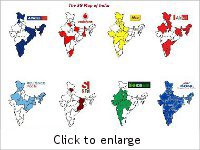 There is a lot of talk about 3G being introduced in the country. But what is it? What does it bring to us? How can we use it? How much do we have to pay for it?
There is a lot of talk about 3G being introduced in the country. But what is it? What does it bring to us? How can we use it? How much do we have to pay for it?
3G is an improvement over the previous generation GSM network, often termed as 2G or second generation. Third generation mobile network (3G) enables high speed data access (at speeds of up to 28 Mbps) and the ability to make video calls, watch live TV on mobiles, and it improves the quality of voice calls.
Availability
3G is available in 700 cities across the country, mostly on BSNL’s network, but private companies are also beginning to start services. Reliance Communication offers 3G in more than 10 cities, including Delhi, Mumbai and Kolkata.
Tata Docomo has also started its services in the nine circles where it has spectrum rights. Recently, Airtel and Aircel started their services in 2-3 cities. By March the private companies will together offer 3G services in about 400 major towns and cities across the country.
People who want to use 3G can do so by opting for any 3G plans offered by their service provider in their area.
Most private service providers have been distributing SIM cards that are compatible with 3G networks. They therefore do not need to change SIMs. However, people who have not changed their SIM for many years will need to get a new one. BSNL advises its subscribers to get a USIM (3G compatible SIM), for which there is no extra charge.
Type of handsets
Not all handsets are capable of using 3G networks. Most operators have a list of 3G capable handsets on their website. Also, remember that 3G networks in India use GSM technology, hence CDMA phones will not work on 3G.
While starting, the phone tells you whether it is an EDGE phone or an HSPA (WCMDA, HSPA, HSUPA, HSDPA or HSPA+) device. Among these, Edge indicates 2G technology; if HSPA, the phone is 3G. You can also refer to your handset maker’s website.
How much will 3G cost?
3G services are more expensive than 2G. Although many operators’ 3G and 2G plans seem identical, due to greater data use, charges are effectively higher.
Call rates for both 2G and 3G remains the same. For data access all service providers charge about 50 paise per MB.
Right now, due to security concerns, no private player offers Video call services. BSNL and MTNL, the only operators that provide this service, charge approximately Rs 3 per minute. There is no separate data charge during the video call.
Services such as mobile TV, online gaming and voice chat are all possible on 3G networks. To access mobile TV, you will need to ask your service provider, and will have to pay separately. However, live video streaming is possible through applications, which you can download from markets such as Android App Market, Ovi store, and Getjar.
Internet radio is another service that works better on 3G, but again you need to ask your operator for this service, and will need to pay extra for it.
What else can you do?
You can play games with other people who are online, and also share information. You can chat while you play and interact with social networking websites at the same time so that you can share your game scores with your friends.
You can also connect your laptop and PC to your phone for accessing the internet on these devices by tethering them to one another. There are phones that support tethering through Wifi. These phones act as Wifi hotspots. Huawei Ideos, Motorola Milestone and iPhone are some of such phones. In case you intend to use the phone for tethering, it is advisable that you take special plans that allow cheaper data access compared to plans that are meant for internet access on mobiles.
We have tried to answer some general questions about 3G here. You can always right to us regarding specific questions you have, that we might have missed; we will be more than happy to help.


